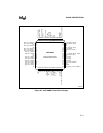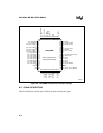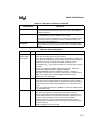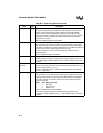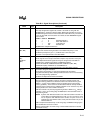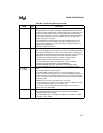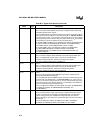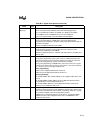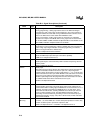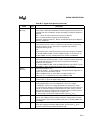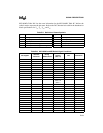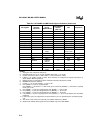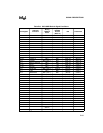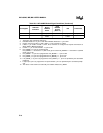
B-19
SIGNAL DESCRIPTIONS
P7.7:0
(MD only)
I/O Port 7
This is a standard, 8-bit, bidirectional port with Schmitt-trigger inputs.
Port 7 is multiplexed as follows: P7.0/EPA4, P7.1/EPA5, P7.2/COMP4,
P7.3/COMP5, and P7.7/FREQOUT. P7.6:4 are not multiplexed.
Port 7 is not implemented on the 8XC196MC and 8XC196MH.
PACT# O Programming Active
During auto programming or ROM-dump, a low signal indicates that
programming or dumping is in progress, while a high signal indicates that the
operation is complete.
PACT# is multiplexed with P2.5 and COMP1.
PALE# I Programming ALE
During slave programming, a falling edge causes the device to read a
command and address from the PBUS.
PALE# is multiplexed with P2.1 and EPA1 (MC, MD) and P2.1, SCLK0#, and
BCLK0 (MH).
PBUS.15:0 I/O Address/Command/Data Bus
During slave programming, ports 3 and 4 serve as a bidirectional port with
open-drain outputs to pass commands, addresses, and data to or from the
device. Slave programming requires external pull-up resistors.
During auto programming and ROM-dump, ports 3 and 4 serve as a regular
system bus to access external memory. P4.6 and P4.7 are left unconnected;
P1.1 and P1.2 serve as the upper address lines.
Slave programming:
PBUS.7:0 are multiplexed with AD7:0 and P3.7:0.
PBUS.15:8 are multiplexed with AD15:8 and P4.7:0.
Auto programming:
On the 8XC196MC, MC, and MH, PBUS.7:0 are multiplexed with AD7:0 and
P3.7:0.
On the 8XC196MC and MD, PBUS.13:8 are multiplexed with AD13:8 and
P4.5:0; PBUS15:14 are multiplexed with P1.2:1.
On the 8XC196MH, PBUS.11:8 are multiplexed with AD11:8 and P4.3:0;
PBUS15:12 are multiplexed with P1.3:0.
PMODE.3:0 I Programming Mode Select
Determines the programming mode. PMODE is sampled after a device reset
and must be static while the microcontroller is operating. (Table 16-7 on page
16-13 lists the PMODE values and programming modes.)
PMODE.3:0 are multiplexed with P0.7:4 and ACH7:4. On the 8XC196MH,
PMODE.2 is also is also multiplexed with T1CLK, and PMODE.3 is also
multiplexed with T1DIR.
Table B-6. Signal Descriptions (Continued)
Name Type Description



